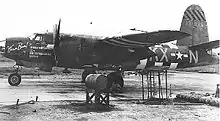RAF Stoney Cross
RAF Stoney Cross is a former World War II airfield in the New Forest, Hampshire, England. The airfield is located approximately 4 miles (6.4 km) northwest of Lyndhurst and 12 miles (19 km) west of Southampton.
| Royal Air Force Station Stoney Cross USAAF Station AAF-452  | |
|---|---|
| Located Near Southampton, Hampshire, England | |
 Aerial Photo Mosaic of Stoney Cross Airfield - 5 September 1943 while additional construction of dispersal hardstands and taxiways on the southwest side of the 07/25 runway. From the air, Stoney Cross was very distinctive, the spur shape being dictated by the terrain on which it was built. The airfield was first planned as an emergency landing ground equipped with facilities. While under construction, the design was changed several times and eventually became a fully equipped airfield and station. | |
 RAF Stoney Cross, shown within Hampshire | |
| Coordinates | 50°55′08″N 001°39′36″W |
| Type | Military airfield |
| Code | SS |
| Site information | |
| Controlled by | Royal Air Force United States Army Air Forces |
| Site history | |
| Built | 1942 |
| In use | 1942-1946 |
| Battles/wars | European Theatre of World War II Air Offensive, Europe July 1942 - May 1945 |
| Garrison information | |
| Garrison | RAF Fighter Command RAF Bomber Command Ninth Air Force RAF Transport Command |
| Occupants | 239 Squadron FC Nos. 297, 299 Squadron BC 367th Fighter Group 387th Bombardment Group |



Opened in 1942, it served both the Royal Air Force and United States Army Air Forces. During the war it functioned primarily as a combat bomber and fighter airfield. It closed in January 1948.
Today the remains of the airfield sit on New Forest Crown land managed by the Forestry Commission.
Overview
Stoney Cross opened in November 1942 and served the Royal Air Force and United States Army Air Forces Ninth Air Force.
USAAF use
Stoney Cross was known as USAAF Station AAF-452 for security reasons during the war, and by which it was referred to instead of location. Its USAAF Station Code was "SS".
367th Fighter Group
The 367th Fighter Group arrived from Oakland Municipal Airport, California flying Lockheed P-38 Lightnings. They had the following fighter squadrons and fuselage codes:
- 392d Fighter Squadron (H5)
- 393d Fighter Squadron (8L)
- 394th Fighter Squadron (4N)
The 367th was a group of Ninth Air Force's 70th Fighter Wing, IX Tactical Air Command. On 6 July the 367th Fighter was moved to nearby RAF Ibsley to make way for the 387th Bomb Group.
387th Bombardment Group (Medium)
With the fighters moved to Ibsley, the Martin B-26 Marauders of the 387th Bombardment Group moved to Stoney Cross from RAF Chipping Ongar on 25 June 1944. They had the following bomber squadrons and fuselage codes:
- 556th Bombardment Squadron (FW)
- 557th Bombardment Squadron (KS)
- 558th Bombardment Squadron (KX)
- 559th Bombardment Squadron (TQ)
The 387th was a group of Ninth Air Force's 98th Bombardment Wing, IX Bomber Command. By 1 September the group was able to move across the English Channel to its Advanced Landing Ground at a captured Luftwaffe airfield, Maupertus-sur-Mer Airfield, France (A-15).
Civil use
Upon its release from military use, the airfield stood neglected. The Forestry Commission, who have managed the crown lands of the New Forest since 1924, took over the management of the site upon its closure. Runways were broken up in the 1960s, putting an end to their use for informal driving lessons,[1] to meet demands for hardcore in the area and most of the usable buildings were sold. The final remaining structure - the water tower - was removed in 2004.
At present a minor C road runs along the length of the main 25/07 runway as a right of way. The other two runways are still clearly visible in aerial photography, although the concrete has been removed. The eastern perimeter road is also in use as a C road. The Forestry Commission has established car parks on three dispersal pans and two campsites make use of other former dispersal sites alongside the eastern 33/15 runway. Almost all of the other dispersal hardstands have been removed, although a few survive in a deteriorated condition. There is a small marker along one of the roads as a memorial to the former airfield and an interpretation board at one of the car parks.
From 1951 to 1954 the accommodation site at Longbeech was used by New Forest District council to house families waiting for council housing. The site had a shop that was open occasionally and a cinema and local tradesmen called regularly. The site was vacated by 1955.
In 1986 RAF Stoney Cross hit the national news when a Hampshire Constabulary led police operation evicted a large group of Peace Convoy travellers from the airfield site. BBC2 recorded the week-long occupation leading to an early-morning eviction in the documentary 'Seven Days At Stoney Cross (1986) [2]
The concrete roads in Longbeech still exist but those on the remainder of the airfield that had survived the earlier 'blitz' were removed in the 1990s.
References
![]() This article incorporates public domain material from the Air Force Historical Research Agency website http://www.afhra.af.mil/.
This article incorporates public domain material from the Air Force Historical Research Agency website http://www.afhra.af.mil/.
- "Bartley,Cadnam & Winsor". 29 December 2011. Retrieved 22 July 2013.
- https://www.youtube.com/watch?v=sIlWi05I-mo
- Freeman, Roger A. (1994) UK Airfields of the Ninth: Then and Now 1994. After the Battle ISBN 0-900913-80-0
- Freeman, Roger A. (1996) The Ninth Air Force in Colour: UK and the Continent-World War Two. After the Battle ISBN 1-85409-272-3
- Maurer, Maurer (1983). Air Force Combat Units Of World War II. Maxwell AFB, Alabama: Office of Air Force History. ISBN 0-89201-092-4.
- www.controltowers.co.uk RAF Stoney Cross
External links
| Wikimedia Commons has media related to RAF Stoney Cross. |
.svg.png.webp)